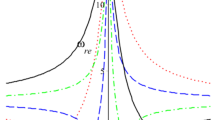Abstract
A study is made of the interaction (“collision”) between two identical laser pulses with lengths much shorter than the diffraction length, propagating in a plasma toward one another. It is shown that the plasma response to the pulses depends essentially on the value of the parameter ωpτ, where ωp is the plasma frequency and τ is the pulse duration. Short laser pulses (such that \(\omega _p \tau \leqslant \sqrt 2 \)) efficiently generate plasma waves on two characteristic scale lengths. Large-scale wake waves with a wavelength of about c/ωp are generated over the entire path of the pulses and form a two-dimensional standing plasma wave in the region between the pulses after their interaction. In the interaction region, the pulses excite small-scale plasma oscillations with a wavelength equal to half the laser wavelength, which remain in the plasma after the interaction. Long laser pulses (such that \(\omega _p \tau \leqslant \sqrt 2 \)) also generate quasistatic plasma perturbations on two scale lengths. Perturbations generated on large scales of about the pulse length accompany the propagating pulses and are somewhat amplified in the interaction between them. Small-scale plasma fields are generated only during the interaction between the pulses, and they disappear after the interaction. The influence of the generation of plasma fields on the energy of the laser pulses and on their shape, as well as the possible applications of the effects under consideration, is discussed.
Similar content being viewed by others
References
M. D. Perry and G. Mourou, Science 264, 917 (1994).
E. Esarey, P. Sprangle, J. Krall, and A. Ting, IEEE Trans. Plasma Sci. 24, 252 (1996).
M. Tabak, J. Hammer, M. E. Glinsky, et al., Phys. Plasmas 1, 1626 (1994).
J. J. Rocca, V. Shlyaptsev, F. G. Tomasel, et al., Phys. Rev. Lett. 73, 2192 (1994).
G. G. Durfee, III and H. M. Milchberg, Phys. Rev. Lett. 71, 2409 (1993).
K. Krushelnick, A. Ting, C. I. Moore, et al., Phys. Rev. Lett. 78, 4047 (1997).
G. Shvets and A. Pukhov, Phys. Rev. E 59, 1033 (1999).
G. Shvets, N. J. Fisch, A. Pukhov, and J. Meyer-ter-Vehn, Phys. Rev. E 60, 2218 (1999).
C. B. Schroeder, P. B. Lee, and J. S. Wurtele, Phys. Rev. E 59, 6037 (1999).
V. M. Malkin, G. Shvets, and N. J. Fisch, Phys. Plasmas 7, 2232 (2000); Phys. Rev. Lett. 84, 1208 (2000).
Y. Ping, I. Geltner, N. J. Fisch, et al., Phys. Rev. E 62, 4532 (2000).
K. Nagashima, J. Koga, and M. Kando, Phys. Rev. E 64, 066403 (2001).
Z.-M. Sheng, K. Mima, Y. Sentoku, et al., Phys. Plasmas 9, 3147 (2002).
L. M. Gorbunov and A. A. Frolov, Zh. Éksp. Teor. Fiz. 120, 583 (2001) [JETP 93, 510 (2001)].
I. Y. Dodin and N. J. Fisch, Phys. Rev. Lett. 88, 165001 (2002).
L. M. Gorbunov and V. I. Kirsanov, Zh. Éksp. Teor. Fiz. 93, 509 (1987) [Sov. Phys. JETP 66, 290 (1987)].
L. M. Gorbunov, P. Mora, and T. M. Antonsen, Jr., Phys. Rev. Lett. 76, 2495 (1996).
V. V. Pustovalov and V. P. Silin, Tr. Fiz. Inst. im. P.N. Lebedeva, Akad. Nauk SSSR 61, 42 (1972).
N. E. Andreev, L. M. Gorbunov, V. I. Kirsanov, et al., Phys. Scripta 49, 101 (1994).
V. P. Silin and A. A. Rukhadze, Electromagnetic Properties of Plasma and Plasmalike Media (Gosatomizdat, Moscow, 1961), p. 90.
J. Bekefi, Radiation Processes in Plasmas (Wiley, New York, 1966; Mir, Moscow, 1971).
Author information
Authors and Affiliations
Additional information
__________
Translated from Fizika Plazmy, Vol. 29, No. 5, 2003, pp. 440–457.
Original Russian Text Copyright © 2003 by Gorbunov, Frolov.
Rights and permissions
About this article
Cite this article
Gorbunov, L.M., Frolov, A.A. Generation of plasma Eields in the interaction between two oppositely propagating short laser pulses in an underdense plasma. Plasma Phys. Rep. 29, 407–424 (2003). https://doi.org/10.1134/1.1575311
Received:
Issue Date:
DOI: https://doi.org/10.1134/1.1575311




